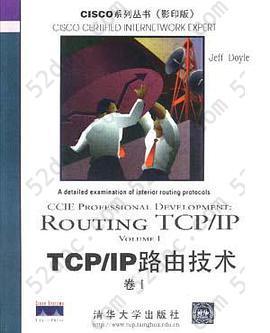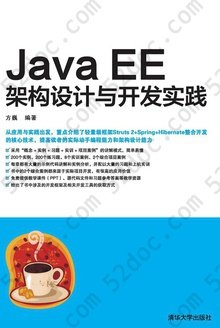注重体验与质量的电子书资源下载网站
分类于: 职场办公 其它
简介

TCP/IP路由技术第1卷 豆 0.0分
资源最后更新于 2020-10-05 18:39:23
作者:多依尔
出版社:清华大学出版社
出版日期:1999-01
ISBN:9787302029496
文件格式: pdf
简介· · · · · ·
内 容 简 介
本书是用于培养Cisco认证的网络互联专家
CCIE的系列丛书的高级教材,详细介绍了当今
流行的Internet网络的关键技术――TCP/IP路由
技术。全书共四大部分,I.介绍路由的基本知
识,包括:地址、路由器、互联以及TCP/IP的
各个协议,静态路由技术和动态路由技术;II.
介绍一系列内部路由协议:路由信息协议RIP、
内部网关路由协议IGRP、第二版的路由信息协
议RIP、扩展内部网关路由协议EIGRP、最短
路径优先OSPF和集成的IS-1S;Ⅲ.介绍路由控
制和互操作性中的各种技术:路由再分布、缺
省路由、路由过滤和路由地图;Ⅳ.相关的附录。
本书在每一章中,不仅有技术讲解,而且有详
实的案例分析以及练习与实验,不仅可作学习
网络的教材,也是网络管理人员的极佳参考书。
目录
Table of Contents
Introduction xxiv
Objectives xxv
Audience xxvi
Organization xxvii
Conventions and Features xxviii
Foreword 1
Chapter1
Routing Basics
Basic Concepts: Internetworks, Routers, and
Addresses
Bicycles with Motors
Data Link Addresses
Repeaters and Bridges
Routers
Network Addresses
Looking Ahead
Recommended Reading
Review Questions
TCP/IP Review
The TCP/IP Protocol Layers
The IP Packet Header
IP Addresses
The First Octet Rule
Address Masks
Subnets and Subnet Masks
Designing Subnets
Breaking the Octet Boundary
Troubleshooting a Subnet Mask
ARP
Proxy ARP
Gratuitous ARP
Reverse ARP
ICMP
The Host-to-Host Layer
CHAPTER 2 TCP
UDP
Looking Ahead
Summary Table: Chapter 2 Command Review
Recommended Reading
Review Questions
Configuration Exercises
Troubleshooting Exercises
CHAPTER 3 Static Routing
The Route Table
Configuring Static Routes
Case Study: Simple Static Routes
Case Study: Summary Routes
Case Study: Alternative Routes
Case Study: Floating Static Routes
Case Study: Load Sharing
Per Destination Load Sharing and Fast
Switching
Per Packet Load Sharing and Process
Switching
Case Study: Recursive Table Lookups
Troubleshooting Static Routes
Case Study: Tracing a Failed Route
Case Study: A Protocol Conflict
Looking Ahead
Summary Table: Chapter 3 Command Review
Review Questions
Configuration Exercises
Troubleshooting Exercises
Chapter 4 Dynamic Routing Protocols
Routing Protocol Basics
Path Determination
Metrics
Hop Count
Bandwidth
Load
Delay
Reliability
Cost
Convergence
Load Balancing
Distance Vector Routing Protocols
Common Characteristics
Periodic Updates
Neighbors
Broadcast Updates
Full Routing Table Updates
Routing by Rumor
Route Invalidation Timers
Split Horizon
Counting to Infinity
Triggered Updates
Holddown Timers
Asynchronous Updates
Link State Routing Protocols
Neighbors
Link State Flooding
Sequence Numbers
Aging
The Link State Database
The SPF Algorithm
Areas
Interior and Exterior Gatewav Protocols
Static or Dynamic Routing?
Looking Ahead
Recommended Reading
Review Questions
Part 11 Interior Routing Protocols
Chapter 5 Routing Information Protocol (RIP)
Operation of RIP
RIP Timers and Stability Features
RIP Message Format
Request Message Types
Classful Routing
Classful Routing: Directly Connected Subnets
Classful Routing: Summarization at Boundary
Routers
Classful Routing: Summary
Configuring RIP 205
Case Study: A Basic RIP Configuration
Case Study: Passive Interfaces
Case Study: Configuring Unicast Updates
Case Study: Discontiguous Subnets
Case Study: Manipulating RIP Metrics
Troubleshooting RIP
Looking Ahead
Summary Table: Chapter 5 Command Review
Recommended Reading
Review Questions
Configuration Exercises
Troubleshooting Exercises
Chapter 6 Interior Gateway Routing Protocol (IGRP)
Operation of IGRP
IGRP Timers and Stability Features
IGRP Metrics
IGRP Packet Format
Configuring IGRP
Case Study: A Basic IGRP Configuration
Case Study: Unequal-Cost Load Balancing
Case Study: Setting Maximum Paths
Case Study: Multiple IGRP Processes
Troubleshooting IGRP 260
Case Study: Unequal-Cost Load Balancing,
Again
Case Study: A Segmented Network
Looking Ahead
Summary Table: Chapter 6 Command Review
Recommended Reading
Review Questions
Configuration Exercises
Troubleshooting Exercises
Chapter 7 Routing Information Protocol Version 2
Operation of RIPv2
RIPv2 Message Format
Compatibility with RIPv
Classless Route Lookups
Classless Routing Protocols
Variable-Length Subnet Masking
Authentication
Configuring RIPv2
Case Study: A Basic RIPv2 Configuration
Case Study: Compatibility with RIPvl
Case Study: Using VLSM
Case Study: Discontiguous Subnets and Classless
Routing
Case Study: Authentication
Troubleshooting RIPv2
Case Study: Misconfigured VLSM
Looking Ahead
Summary Table: Chapter 7 Command Review
Recommended Reading
Review Questions
Configuration Exercises
Troubleshooting Exercises
Chapter 8 Enhanced Interior Gateway Routing Protocol
(EIGRP)
Operation of EIGRP
Protocol-Dependent Modules
Reliable Transport Protocol
Neighbor Discovery/Recovery
The Diffusing Update Algorithm
DUAL: Preliminary Concepts
The DUAL Finite State Machine
Diffusing Computation: Example 1
Diffusing Computation: Example 2
EIGRP Packet Formats
The EIGRP Packet Header
General TLV Fields
IP-Specific TLV Fields
Address Aggregation
Configuring EIGRP
Case Study: A Basic ETCRP Configuration
Case Study: Redistribution with IGRP
Case Study: Disabling Automatic Summarization
Case Study: Address Aggregation
Authentication
Troubleshooting EIGRP
Case Study: A Missing Neighbor
Stuck-in-Active Neighbors
Looking Ahead
Summary Table: Chapter 8 Command review
Review Questions
Configuration Exercises
Troubleshooting Exercises
Chapter 9 Open Shortest Path First
Operation of OSPF
Neighbors and Adjacencies
The Hello Protocol
Network Types
Designated Routers and Backup Designated
Routers
OSPF Interfaces
OSPF Neighbors
Flooding
Areas
Router Types
Partitioned Areas
Virtual Links
The Link State Database
LSA Types
Stub Areas
The Route Table
Destination Types
Path Types
Route Table Lookups
Authentication
OSPF over Demand Circuits
OSPF Packet Formats
The Packet Header
The Hello Packet
The Database Description Packet
The Link State Request Packet
The Link State Update Packet
The Link State Acknowledgment Packet.
OSPF LSA Formats
The LSA Header
The Router LSA
The Network LSA
The Network and ASBR Summary LSAs
The Autonomous System External LSA
The NSSA External LSA
The Options Field
Configuring OSPF
Case Study: A Basic OSPF Configuration
Case Study: Setting Router IDs with Loopback
Interfaces
Case Study: Domain Name Service Lookups
Case Study: OSPF and Secondary Addresses
Case Study: Stub Areas
Case Study: Totally Stubby Areas
Case Study: Not-So-Stubby Areas
Case Study: Address Summarization
Case Study: Authentication
Case Study: Virtual Links
Case Study: OSPF on NBMA Networks
Case Study: OSPF over Demand Circuits
Troubleshooting OSPF
Case Study: An Isolated Area
Case Study: Misconfigured Summarization
Looking Ahead
Summary Table: Chapter 9 Command Review
Recommended Reading
Review Questions
Configuration Exercises
Troubleshooting Exercises
Chapter 10 Integrated IS-IS 592
Operation of Integrated IS-IS
IS-IS Areas
Network Entity Titles
IS-IS Functional Organization
Subnetwork Dependent Functions
Subnetwork Independent Functions
IS-IS PDU Formats
CLV Fields
The IS-IS Hello PDU Format
The IS-IS Link State PDU Format
The IS-IS Sequence Numbers PDU Format
Configuring Integrated IS-IS
Case Study: A Basic Integrated IS-IS
Configuration
Case Study: Changing the Router Types
Case Study: An Area Migration
Case Study: Route Summarization
Case Study: Authentication
Troubleshooting Integrated IS-IS
Troubleshooting IS-IS Adjacencies
Troubleshooting the IS-IS Link State Database
Case Study: Integrated IS-IS on NBMA
Networks
Looking Ahead
Summary Table: Chapter 10 Command Review
Review Questions
Configuration Exercises
Troubleshooting Exercises
Part 111 Route Control and Interoperability
Chapter 11 Route Redistribution
Principles of Redistribution
Metrics
Administrative Distances
Redistributing from Classless to Classful
Protocols
Configuring Redistribution
Case Study: Redistributing IGRP and RIP
Case Study: Redistributing EIGRP and OS
Case Study: Redistribution and Route
Summarization
Case Study: Redistributing IS-IS and RIP
Case Study: Redistributing Static Routes
Looking Ahead
Summary Table: Chapter 11 Command Review
Review Questions
Configuration Exercises
Troubleshooting Exercises
Chapter 12 Default Routes and On-Demand Routing
Fundamentals of Default Routes
Fundamentals of On-Demand Routing
Configuring Default Routes and ODR
Case Study: Static Default Routes
Case Study: The Default-Network Command
Case Study: The Default-Information Originate
Command
Case Study: Configuring On-Demand Routing
Looking Ahead
Summary Table: Chapter 12 Command Review
Review Questions
Chapter 13 Route Filtering
Configuring Route Filters
Case Study: Filtering Specific Routes
Case Study: Route Filtering and Redistribution
Case Study: A Protocol Migration
Case Study: Multiple Redistribution Points
Case Study: Using Distances to Set Router Pref-
erences
Looking Ahead
Summary Table: Chapter 13 Command Review
Configuration Exercises
Troubleshooting Exercises
Chapter 14 Route Maps
Basic Uses of Route Maps
Configuring Route Maps
Case Study: Policy Routing
Case Study: Policy Routing and Quality of Ser-
vice Routing
Case Study: Route Maps and Redistribution
Case Study: Route Tagging
Looking Ahead
Summary Table: Chapter 14 Command Review
Review Questions
Configuration Exercises
Troubleshooting Exercises
Part IV Appendixes
Appendix A Tutoriat: Working with Binary and Hex
Working with Binary Numbers
Working with Hexadecimal Numbers
Appendix B Tutorial: Access Lists
Access List Basics
Implicit Deny Any
Sequentiality
Access List Types
Editing Access Lists
Standard IP Access Lists
Extended IP Access Lists
TCP Access Lists
UDP Access Lists
ICMP Access Lists
Calling the Access List
Keyword Alternatives
Named Access Lists
Filter Placement Considerations
Access List Monitoring and Accounting
Appendix C CCIE Preparation Tips
Laying the Foundations
Hands-On Experience
Intensifying the Study
The Final Six Months
Exam Day 889
Appendix D Answers to Review Questions
Chapter 1
Chapter 2
Chapter 3
Chapter 4
Chapter 5
Chapter 6
Chapter 7
Chapter 8
Chapter 9
Chapter 10
Chapter 11
Chapter 12
Chapter 14
Appendix E Solutions to Configuration Problems
Chapter 2
Chapter 3
Chapter 5
Chapter 6
Chapter 7
Chapter 8
Chapter 9
Chapter 10
Chapterll
Chapter 13
Chapter 14
Appendix F Solutions to Troubleshooting Exercises
Chapter 2
Chapter 3
Chapter 5
Chapter 6
Chapter 7
Chapter 8
Chapter 9
Chapter 10
Chapter 11
Chapter 13
Chapter 14
Index
Introduction xxiv
Objectives xxv
Audience xxvi
Organization xxvii
Conventions and Features xxviii
Foreword 1
Chapter1
Routing Basics
Basic Concepts: Internetworks, Routers, and
Addresses
Bicycles with Motors
Data Link Addresses
Repeaters and Bridges
Routers
Network Addresses
Looking Ahead
Recommended Reading
Review Questions
TCP/IP Review
The TCP/IP Protocol Layers
The IP Packet Header
IP Addresses
The First Octet Rule
Address Masks
Subnets and Subnet Masks
Designing Subnets
Breaking the Octet Boundary
Troubleshooting a Subnet Mask
ARP
Proxy ARP
Gratuitous ARP
Reverse ARP
ICMP
The Host-to-Host Layer
CHAPTER 2 TCP
UDP
Looking Ahead
Summary Table: Chapter 2 Command Review
Recommended Reading
Review Questions
Configuration Exercises
Troubleshooting Exercises
CHAPTER 3 Static Routing
The Route Table
Configuring Static Routes
Case Study: Simple Static Routes
Case Study: Summary Routes
Case Study: Alternative Routes
Case Study: Floating Static Routes
Case Study: Load Sharing
Per Destination Load Sharing and Fast
Switching
Per Packet Load Sharing and Process
Switching
Case Study: Recursive Table Lookups
Troubleshooting Static Routes
Case Study: Tracing a Failed Route
Case Study: A Protocol Conflict
Looking Ahead
Summary Table: Chapter 3 Command Review
Review Questions
Configuration Exercises
Troubleshooting Exercises
Chapter 4 Dynamic Routing Protocols
Routing Protocol Basics
Path Determination
Metrics
Hop Count
Bandwidth
Load
Delay
Reliability
Cost
Convergence
Load Balancing
Distance Vector Routing Protocols
Common Characteristics
Periodic Updates
Neighbors
Broadcast Updates
Full Routing Table Updates
Routing by Rumor
Route Invalidation Timers
Split Horizon
Counting to Infinity
Triggered Updates
Holddown Timers
Asynchronous Updates
Link State Routing Protocols
Neighbors
Link State Flooding
Sequence Numbers
Aging
The Link State Database
The SPF Algorithm
Areas
Interior and Exterior Gatewav Protocols
Static or Dynamic Routing?
Looking Ahead
Recommended Reading
Review Questions
Part 11 Interior Routing Protocols
Chapter 5 Routing Information Protocol (RIP)
Operation of RIP
RIP Timers and Stability Features
RIP Message Format
Request Message Types
Classful Routing
Classful Routing: Directly Connected Subnets
Classful Routing: Summarization at Boundary
Routers
Classful Routing: Summary
Configuring RIP 205
Case Study: A Basic RIP Configuration
Case Study: Passive Interfaces
Case Study: Configuring Unicast Updates
Case Study: Discontiguous Subnets
Case Study: Manipulating RIP Metrics
Troubleshooting RIP
Looking Ahead
Summary Table: Chapter 5 Command Review
Recommended Reading
Review Questions
Configuration Exercises
Troubleshooting Exercises
Chapter 6 Interior Gateway Routing Protocol (IGRP)
Operation of IGRP
IGRP Timers and Stability Features
IGRP Metrics
IGRP Packet Format
Configuring IGRP
Case Study: A Basic IGRP Configuration
Case Study: Unequal-Cost Load Balancing
Case Study: Setting Maximum Paths
Case Study: Multiple IGRP Processes
Troubleshooting IGRP 260
Case Study: Unequal-Cost Load Balancing,
Again
Case Study: A Segmented Network
Looking Ahead
Summary Table: Chapter 6 Command Review
Recommended Reading
Review Questions
Configuration Exercises
Troubleshooting Exercises
Chapter 7 Routing Information Protocol Version 2
Operation of RIPv2
RIPv2 Message Format
Compatibility with RIPv
Classless Route Lookups
Classless Routing Protocols
Variable-Length Subnet Masking
Authentication
Configuring RIPv2
Case Study: A Basic RIPv2 Configuration
Case Study: Compatibility with RIPvl
Case Study: Using VLSM
Case Study: Discontiguous Subnets and Classless
Routing
Case Study: Authentication
Troubleshooting RIPv2
Case Study: Misconfigured VLSM
Looking Ahead
Summary Table: Chapter 7 Command Review
Recommended Reading
Review Questions
Configuration Exercises
Troubleshooting Exercises
Chapter 8 Enhanced Interior Gateway Routing Protocol
(EIGRP)
Operation of EIGRP
Protocol-Dependent Modules
Reliable Transport Protocol
Neighbor Discovery/Recovery
The Diffusing Update Algorithm
DUAL: Preliminary Concepts
The DUAL Finite State Machine
Diffusing Computation: Example 1
Diffusing Computation: Example 2
EIGRP Packet Formats
The EIGRP Packet Header
General TLV Fields
IP-Specific TLV Fields
Address Aggregation
Configuring EIGRP
Case Study: A Basic ETCRP Configuration
Case Study: Redistribution with IGRP
Case Study: Disabling Automatic Summarization
Case Study: Address Aggregation
Authentication
Troubleshooting EIGRP
Case Study: A Missing Neighbor
Stuck-in-Active Neighbors
Looking Ahead
Summary Table: Chapter 8 Command review
Review Questions
Configuration Exercises
Troubleshooting Exercises
Chapter 9 Open Shortest Path First
Operation of OSPF
Neighbors and Adjacencies
The Hello Protocol
Network Types
Designated Routers and Backup Designated
Routers
OSPF Interfaces
OSPF Neighbors
Flooding
Areas
Router Types
Partitioned Areas
Virtual Links
The Link State Database
LSA Types
Stub Areas
The Route Table
Destination Types
Path Types
Route Table Lookups
Authentication
OSPF over Demand Circuits
OSPF Packet Formats
The Packet Header
The Hello Packet
The Database Description Packet
The Link State Request Packet
The Link State Update Packet
The Link State Acknowledgment Packet.
OSPF LSA Formats
The LSA Header
The Router LSA
The Network LSA
The Network and ASBR Summary LSAs
The Autonomous System External LSA
The NSSA External LSA
The Options Field
Configuring OSPF
Case Study: A Basic OSPF Configuration
Case Study: Setting Router IDs with Loopback
Interfaces
Case Study: Domain Name Service Lookups
Case Study: OSPF and Secondary Addresses
Case Study: Stub Areas
Case Study: Totally Stubby Areas
Case Study: Not-So-Stubby Areas
Case Study: Address Summarization
Case Study: Authentication
Case Study: Virtual Links
Case Study: OSPF on NBMA Networks
Case Study: OSPF over Demand Circuits
Troubleshooting OSPF
Case Study: An Isolated Area
Case Study: Misconfigured Summarization
Looking Ahead
Summary Table: Chapter 9 Command Review
Recommended Reading
Review Questions
Configuration Exercises
Troubleshooting Exercises
Chapter 10 Integrated IS-IS 592
Operation of Integrated IS-IS
IS-IS Areas
Network Entity Titles
IS-IS Functional Organization
Subnetwork Dependent Functions
Subnetwork Independent Functions
IS-IS PDU Formats
CLV Fields
The IS-IS Hello PDU Format
The IS-IS Link State PDU Format
The IS-IS Sequence Numbers PDU Format
Configuring Integrated IS-IS
Case Study: A Basic Integrated IS-IS
Configuration
Case Study: Changing the Router Types
Case Study: An Area Migration
Case Study: Route Summarization
Case Study: Authentication
Troubleshooting Integrated IS-IS
Troubleshooting IS-IS Adjacencies
Troubleshooting the IS-IS Link State Database
Case Study: Integrated IS-IS on NBMA
Networks
Looking Ahead
Summary Table: Chapter 10 Command Review
Review Questions
Configuration Exercises
Troubleshooting Exercises
Part 111 Route Control and Interoperability
Chapter 11 Route Redistribution
Principles of Redistribution
Metrics
Administrative Distances
Redistributing from Classless to Classful
Protocols
Configuring Redistribution
Case Study: Redistributing IGRP and RIP
Case Study: Redistributing EIGRP and OS
Case Study: Redistribution and Route
Summarization
Case Study: Redistributing IS-IS and RIP
Case Study: Redistributing Static Routes
Looking Ahead
Summary Table: Chapter 11 Command Review
Review Questions
Configuration Exercises
Troubleshooting Exercises
Chapter 12 Default Routes and On-Demand Routing
Fundamentals of Default Routes
Fundamentals of On-Demand Routing
Configuring Default Routes and ODR
Case Study: Static Default Routes
Case Study: The Default-Network Command
Case Study: The Default-Information Originate
Command
Case Study: Configuring On-Demand Routing
Looking Ahead
Summary Table: Chapter 12 Command Review
Review Questions
Chapter 13 Route Filtering
Configuring Route Filters
Case Study: Filtering Specific Routes
Case Study: Route Filtering and Redistribution
Case Study: A Protocol Migration
Case Study: Multiple Redistribution Points
Case Study: Using Distances to Set Router Pref-
erences
Looking Ahead
Summary Table: Chapter 13 Command Review
Configuration Exercises
Troubleshooting Exercises
Chapter 14 Route Maps
Basic Uses of Route Maps
Configuring Route Maps
Case Study: Policy Routing
Case Study: Policy Routing and Quality of Ser-
vice Routing
Case Study: Route Maps and Redistribution
Case Study: Route Tagging
Looking Ahead
Summary Table: Chapter 14 Command Review
Review Questions
Configuration Exercises
Troubleshooting Exercises
Part IV Appendixes
Appendix A Tutoriat: Working with Binary and Hex
Working with Binary Numbers
Working with Hexadecimal Numbers
Appendix B Tutorial: Access Lists
Access List Basics
Implicit Deny Any
Sequentiality
Access List Types
Editing Access Lists
Standard IP Access Lists
Extended IP Access Lists
TCP Access Lists
UDP Access Lists
ICMP Access Lists
Calling the Access List
Keyword Alternatives
Named Access Lists
Filter Placement Considerations
Access List Monitoring and Accounting
Appendix C CCIE Preparation Tips
Laying the Foundations
Hands-On Experience
Intensifying the Study
The Final Six Months
Exam Day 889
Appendix D Answers to Review Questions
Chapter 1
Chapter 2
Chapter 3
Chapter 4
Chapter 5
Chapter 6
Chapter 7
Chapter 8
Chapter 9
Chapter 10
Chapter 11
Chapter 12
Chapter 14
Appendix E Solutions to Configuration Problems
Chapter 2
Chapter 3
Chapter 5
Chapter 6
Chapter 7
Chapter 8
Chapter 9
Chapter 10
Chapterll
Chapter 13
Chapter 14
Appendix F Solutions to Troubleshooting Exercises
Chapter 2
Chapter 3
Chapter 5
Chapter 6
Chapter 7
Chapter 8
Chapter 9
Chapter 10
Chapter 11
Chapter 13
Chapter 14
Index








